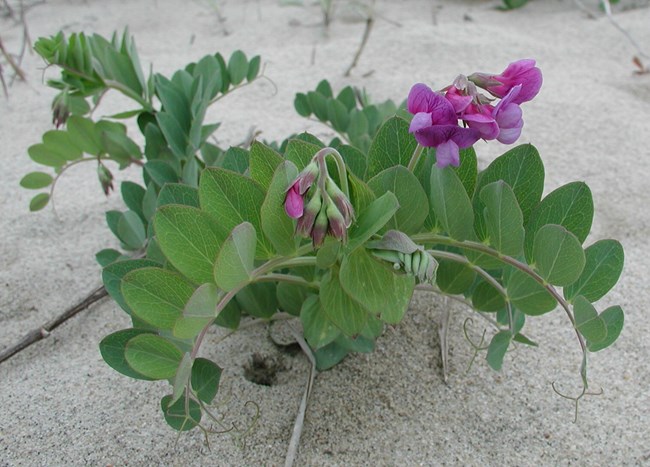
Photo by Anita Gould
https://creativecommons.org/licenses/by-nc/2.0/legalcode
Historically beach pea was a common coastal plant along the foredunes and blowouts of what is now Indiana Dunes National Park. Recreational pressure undoubtedly had some impact on the plant’s disappearance, but it was not the lone culprit. The plant thrives best where there is a fair amount of sand movement. Local towns built shoreline structures like jetties and breakwaters at Michigan City, the Port of Indiana, Burns Waterway and elsewhere, and these hard surfaces stopped the natural transport of sand. Sand became trapped on the east side of the structures, and was no longer able to replace the sand that was being eroded from the shoreline farther to the west. With no new sand moving in to replenish the sand eroding away, there was little sand available to form foredunes, one of the endangered plant’s preferred habitats.
Since 2007, the staff at Indiana Dunes National Park (at that time called “Indiana Dunes National Lakeshore”) has worked diligently to reestablish beach pea populations within the park. John Dollard, a Biological Science Technician at the time, initiated the beach pea experimental reintroduction study. Before starting the study, John traveled to many locations where beach pea was found around the Great Lakes and recorded his observations about the habitat conditions in which beach pea populations thrived. Using this information and more, he developed a pilot study in 2007, and in 2008, established research plots for his master’s thesis, “Experimental Reintroduction of Beach Pea to the Indiana Dunes National Lakeshore” (Dollard and Carrington, 2013).
Dollard received permission to collect seed from plants growing at Indiana Dunes State Park, and planted those seeds in a greenhouse built by the lakeshore’s botany staff. After two years, the plants flowered and produced seed. In his experiment, Dollard planted beach pea in both foredune and blowout habitats. Half of plants received water and other half did not. To water the plants, Dollard carried water from the lake in a backpack pump and once at the site, transferred it into a watering can. During the summer, experimental plots required water application three times per week. Plant measurements and moisture readings were also taken weekly.
A great deal was learned during the project that has made subsequent efforts to establish beach pea populations even more successful. Statistical analysis showed that plants grown closer to the lake and that had larger stem size survived better.
Beach pea plants growing at an experimental site on the west end of the park have survived better and in the long term this site continues to do the best. Those planted on the crest of the foredune were not buried in sand and did not succumb to high lake levels and erosion from storm waves. Plants grown in the facility for a full season and planted in fall fared better than spring planted beach peas, and also required no supplemental watering.
Seeds were collected annually from plants in the growing facility and at the western experimental foredune site. Seeds were cold stratified in winter and germinated in early March. The beach peas are watered and fertilized in the greenhouse during the spring/summer. Each fall, Dollard’s team planted 300-400 plants.
The scientific study and annual field planting/observations have improved the park’s restoration strategies. In 2015, over 400 plants were thriving in the park. Recently, high lake levels and severe fall storms have destroyed embryonic foredunes. Some plants are now planted further landward on fixed dunes, to avoid total destruction of the transplants.
To Dollard, the most exciting part of the project was learning that we really CAN save the beach pea in Indiana. Reintroduction of endangered plants is a long-term investment, and Indiana Dunes National Park is committed to the conservation of this coastal plant.
Dollard’s work has yielded the following tips for restoring beach pea populations:
Protocols for future reintroduction
• Conduct reintroductions in several locations to reduce risk of extirpation
• Prevent trampling by locating reintroduction sites to remote areas
• Use annual fall outplanting to increase the population of existing reintroductions
• Grow plants in a greenhouse for 6–12 months to increase plant survival – plant in fall
• Install sand barriers during the first year of seedling establishment (Dollard and Carrington, 2013)
• Larger initially planted seedlings survived better
• Plants in foredunes have better survival than those in blowouts
Citations:
Dollard, J., and M. Carrington, 2013. Experimental Reintroduction of beach pea (Lathyrus japonicus) to the Indiana Dunes National Lakeshore. Ecological Restoration Vol. 31:368-377.
Click here for an article detailing Dollard’s investigation entitled “Experimental reintroduction of state-endangered beach pea (Lathyrus japonicus) to Indiana Dunes National Lakeshore” which appeared in Park Science in Spring of 2018.
Last updated: September 19, 2019
